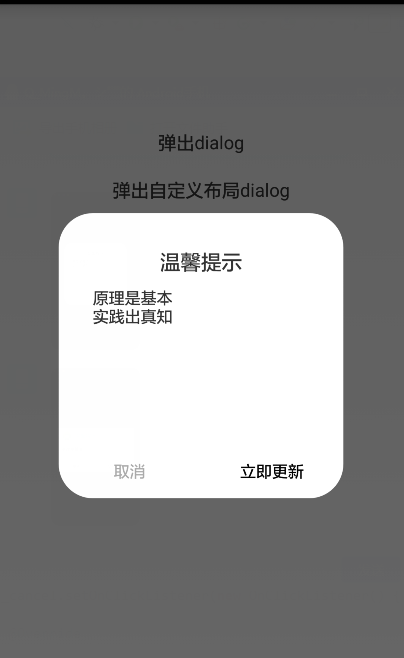【转】Android AlertDialog自定义布局
原文网址:https://blog.csdn.net/u010694658/article/details/53022294
由于开发中经常使用弹框,然而系统自带的弹框太局限,也不太美观,经常不能满足开发需求,所以就只能自定义布局。其实自定义布局很简单,没不要写出来,但是如果不写一遍的,后面遇到的话就感觉又会忘记,所以在次记一小笔,仅记一个最简单的例子,可以举一反三。
直接上代码
public class MainActivity extends Activity implements OnClickListener {
private TextView text1, text2;
private Context mContext;
@Override
protected void onCreate(Bundle savedInstanceState) {
super.onCreate(savedInstanceState);
requestWindowFeature(Window.FEATURE_NO_TITLE);
setContentView(R.layout.activity_main);
mContext = this;
initView();
}
private void initView() {
text1 = (TextView) findViewById(R.id.text1);
text2 = (TextView) findViewById(R.id.text2);
text1.setOnClickListener(this);
text2.setOnClickListener(this);
}
@Override
public void onClick(View v) {
switch (v.getId()) {
case R.id.text1:
dialogShow1();
break;
case R.id.text2:
dialogShow2();
break;
default:
break;
}
}
private void dialogShow1() {
AlertDialog.Builder builder = new Builder(mContext);
builder.setTitle("温馨提示");
builder.setIcon(R.drawable.ic_launcher);
builder.setMessage("原理是基本");
builder.setNegativeButton("取消", new DialogInterface.OnClickListener() {
@Override
public void onClick(DialogInterface arg0, int arg1) {
Toast.makeText(mContext, "no", 1).show();
}
});
builder.setPositiveButton("立即更新",
new DialogInterface.OnClickListener() {
@Override
public void onClick(DialogInterface arg0, int arg1) {
Toast.makeText(mContext, "ok", 1).show();
}
});
Dialog dialog = builder.create();
dialog.show();
}
/**
* 自定义布局
* setView()只会覆盖AlertDialog的Title与Button之间的那部分,而setContentView()则会覆盖全部,
* setContentView()必须放在show()的后面
*/
private void dialogShow2() {
AlertDialog.Builder builder = new Builder(mContext);
LayoutInflater inflater = LayoutInflater.from(mContext);
View v = inflater.inflate(R.layout.update_manage_dialog, null);
TextView content = (TextView) v.findViewById(R.id.dialog_content);
Button btn_sure = (Button) v.findViewById(R.id.dialog_btn_sure);
Button btn_cancel = (Button) v.findViewById(R.id.dialog_btn_cancel);
//builer.setView(v);//这里如果使用builer.setView(v),自定义布局只会覆盖title和button之间的那部分
final Dialog dialog = builder.create();
dialog.show();
dialog.getWindow().setContentView(v);//自定义布局应该在这里添加,要在dialog.show()的后面
//dialog.getWindow().setGravity(Gravity.CENTER);//可以设置显示的位置
btn_sure.setOnClickListener(new OnClickListener() {
@Override
public void onClick(View v) {
dialog.dismiss();
Toast.makeText(mContext, "ok", 1).show();
}
});
btn_cancel.setOnClickListener(new OnClickListener() {
@Override
public void onClick(View arg0) {
dialog.dismiss();
Toast.makeText(mContext, "no", 1).show();
}
});
}
}activity_main的布局
<LinearLayout xmlns:android="http://schemas.android.com/apk/res/android"
xmlns:tools="http://schemas.android.com/tools"
android:layout_width="match_parent"
android:layout_height="match_parent"
android:layout_marginTop="100dp"
android:orientation="vertical" >
<TextView
android:id="@+id/text1"
android:layout_width="match_parent"
android:layout_height="wrap_content"
android:layout_margin="10dp"
android:gravity="center"
android:text="弹出dialog"
android:textSize="@dimen/activity_horizontal_margin" />
<TextView
android:id="@+id/text2"
android:layout_width="match_parent"
android:layout_height="wrap_content"
android:layout_margin="10dp"
android:gravity="center"
android:text="弹出自定义布局dialog"
android:textSize="@dimen/activity_horizontal_margin" />
</LinearLayout>update_manage_dialog布局
<RelativeLayout xmlns:android="http://schemas.android.com/apk/res/android"
xmlns:tools="http://schemas.android.com/tools"
android:layout_width="match_parent"
android:layout_height="match_parent"
android:background="#00FFFFFF" >
<RelativeLayout
android:layout_width="250dp"
android:layout_height="250dp"
android:layout_centerInParent="true"
android:background="@drawable/update_bg" >
<TextView
android:id="@+id/dialog_title"
android:layout_width="match_parent"
android:layout_height="wrap_content"
android:layout_marginTop="30dp"
android:gravity="center"
android:text="温馨提示"
android:textSize="18sp" />
<TextView
android:id="@+id/dialog_content"
android:layout_width="match_parent"
android:layout_height="wrap_content"
android:layout_below="@+id/dialog_title"
android:layout_marginTop="10dp"
android:layout_marginLeft="30dp"
android:layout_marginRight="30dp"
android:text="原理是基本\n实践出真知"
android:textSize="14sp" />
<LinearLayout
android:layout_width="match_parent"
android:layout_height="wrap_content"
android:layout_alignParentBottom="true"
android:orientation="horizontal" >
<Button
android:id="@+id/dialog_btn_cancel"
android:layout_width="0dp"
android:layout_height="wrap_content"
android:layout_weight="1"
android:background="@null"
android:text="取消"
android:textColor="#AAAAAA"
android:textSize="14sp" />
<Button
android:id="@+id/dialog_btn_sure"
android:layout_width="0dp"
android:layout_height="wrap_content"
android:layout_weight="1"
android:background="@null"
android:text="立即更新"
android:textSize="14sp" />
</LinearLayout>
</RelativeLayout>
</RelativeLayout>update_bg放在drawable里面,代码如下
<?xml version="1.0" encoding="utf-8"?>
<shape xmlns:android="http://schemas.android.com/apk/res/android" >
<!-- android:radius 弧形的半径 -->
<corners android:radius="30dp" />
<!-- 填充的颜色 -->
<solid android:color="@android:color/white" />
</shape>【转】Android AlertDialog自定义布局的更多相关文章
- Android 创建自定义布局
我们所有的控件都是继承至View类的,而所有的布局都是继承至ViewGroup的,所以我们也可以继承某个view类来实现我们自己的布局或者控件. 引入布局 我们新建一个title.xml的layout ...
- 获取 AlertDialog自定义的布局 的控件
AlertDialog自定义的布局 效果图: 创建dialog方法的代码如下: 1 LayoutInflater inflater = getLayoutInflater(); 2 View layo ...
- Android之自定义AlertDialog和PopupWindow实现(仿微信Dialog)
我们知道,在很多时候,我们都不用Android内置的一些控件,而是自己自定义一些自己想要的控件,这样显得界面更美观. 今天主要是讲自定义AlertDialog和popupWindow的使用,在很多需求 ...
- Android之自定义AlertDialog无法监听控件
参考:http://www.cnblogs.com/511mr/archive/2011/10/21/2220253.html 要做一个自定义的弹出框,以前都是用一个Activity来实现,总觉得不是 ...
- Android:创建可穿戴应用 - 自定义布局
创建自定义布局(Creating Custom Layouts) 本文将介绍如何创建自定义通知以及使用可穿戴UI库来创建自定义布局你同时还需要了解可穿戴设计准则(Wear Design Princip ...
- 【Android基础】listview控件的使用(4)-----自定义布局的listview的使用
前面我介绍了listview控件的不同用法,但是这些用法在实际的开发项目中是不足以满足需求的,因为前面的几种用法只能简单的显示文本信息,而且布局都比较单一,很难做出复杂的结果,在实际的开发项目中,90 ...
- Android开发学习之路--UI之自定义布局和控件
新的一年已经开始了,今天已经是初二了,两天没有学习了,还是要来继续学习下.一般手机的title都是actionbar,就像iphone一样可以后退,可以编辑.这里自定义布局就来实现下这个功能,首先准备 ...
- Android创建自定义的布局和控件
Android的自带布局有framelayout.linerlayout.relativelayout,外加两个百分比布局,但是这些无法灵活的满足我们的需要,所以我们要自己自定义并引入自己的布局.首先 ...
- android 开发 使用自定义布局实现标题栏复用(标题栏内容自定义:使用代码实现和xml布局自定义属性2种办法实现)
在个人学习的情况下可能很少使用自定义布局去实现大量复用的情况下,但是在一个开发工作的环境下就会使用到大量复用的自定义控件. 实现思维: 1.写一个xml的布局,用于标题栏的样式,并且添加在标题栏中你想 ...
随机推荐
- 创建自己的docker基础镜像
1.下载镜像 centos7 docker pull centos: 2.创建容器加载镜像 docker run -i -t --name centos7 centos: docker run 参数详 ...
- L293 给地球降温
Countries look at ways to tinker with Earth’s thermostat The idea of cooling the climate with strato ...
- 性能测试-2.Fiddler抓包工具的使用
Fiddler基础知识(此文原文地址) Fiddler是强大的抓包工具,它的原理是以web代理服务器的形式进行工作的,使用的代理地址是:127.0.0.1,端口默认为8888,我们也可以通过设置进行修 ...
- Semaphore计数信号量
ExecutorService exec = Executors.newCachedThreadPool(); final Semaphore semp = new Semaphore(5); for ...
- eclipse逆向生成hibernate的实体类(注解和配置文件)
eclipse从数据库逆向生成Hibernate实体类(注解和配置文件) 分类: hibernate 数据库 java 2011-10-22 21:28 2915人阅读 评论(8) 收藏 举报 做项目 ...
- AMM调整为ASMM命令(关闭memory_target自动管理方式)
客户生产系统,AIX oracle 11.2.0.4 数据库版本,2节点RAC. 操作系统内存,均为125G,调整前,使用oracle memory_target自动调整分配方式,memory_max ...
- ImportError: No module named 'xml'
/********************************************************************************* * ImportError: No ...
- Java中的内部类————以及jdk1.8的lambda表达式
一.内部类学习导图 1>.静态内部类: 使用static修饰符来修饰内部类,则这个内部类就属于外部类本身,而不属于外部类的某个对象.因此使用static修饰的内部类被称为静态内部类. publi ...
- N!的近似值_斯特林公式
公式: N! ~= sqrt(2 * PI * n) * ((n / e) ^n) 题目类型不慌都.
- [LeetCode&Python] Problem 107. Binary Tree Level Order Traversal II
Given a binary tree, return the bottom-up level order traversal of its nodes' values. (ie, from left ...


